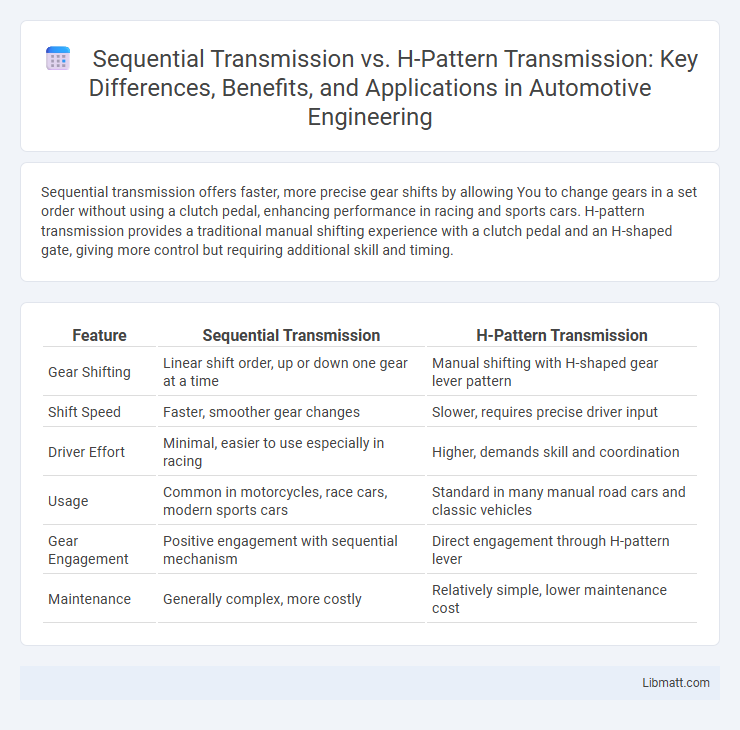Sequential transmission offers faster, more precise gear shifts by allowing You to change gears in a set order without using a clutch pedal, enhancing performance in racing and sports cars. H-pattern transmission provides a traditional manual shifting experience with a clutch pedal and an H-shaped gate, giving more control but requiring additional skill and timing.
Table of Comparison
| Feature | Sequential Transmission | H-Pattern Transmission |
|---|---|---|
| Gear Shifting | Linear shift order, up or down one gear at a time | Manual shifting with H-shaped gear lever pattern |
| Shift Speed | Faster, smoother gear changes | Slower, requires precise driver input |
| Driver Effort | Minimal, easier to use especially in racing | Higher, demands skill and coordination |
| Usage | Common in motorcycles, race cars, modern sports cars | Standard in many manual road cars and classic vehicles |
| Gear Engagement | Positive engagement with sequential mechanism | Direct engagement through H-pattern lever |
| Maintenance | Generally complex, more costly | Relatively simple, lower maintenance cost |
Introduction to Transmission Systems
Sequential transmissions provide faster gear shifts with minimal interruption in power delivery, enhancing performance and efficiency in modern vehicles. H-pattern transmissions use a traditional manual shift layout with a distinct gate for each gear, offering intuitive control and reliability for everyday driving. Understanding these transmission systems helps in selecting the right mechanism based on driving style and vehicle requirements.
What is Sequential Transmission?
Sequential transmission is a type of manual gearbox that allows drivers to shift gears in a linear order without the need to navigate an H-pattern layout. This transmission system uses a mechanism where each gear change is made by moving a lever forward or backward sequentially, facilitating quicker and more precise shifts. Commonly found in motorcycles and race cars, sequential transmissions offer improved performance and reduce the chance of missed shifts compared to traditional H-pattern transmissions.
What is H-Pattern Transmission?
H-Pattern Transmission features a traditional manual gearbox layout where gear shifts follow an H-shaped pattern, allowing direct control over each gear and reverse. This system is commonly found in older or classic vehicles and requires precise clutch manipulation and timing during gear changes. Your driving experience with an H-Pattern Transmission emphasizes mechanical engagement and skill, contrasting with the quicker, more automated shifts of sequential gearboxes.
Key Differences Between Sequential and H-Pattern Transmissions
Sequential transmissions allow drivers to shift gears in a fixed order using a simple forward or backward motion, providing faster and more precise gear changes ideal for performance driving. H-pattern transmissions require maneuvering the gear lever through a traditional "H"-shaped gate, enabling more control over gear selection but often resulting in slower shifts. Your choice between the two depends on whether you prioritize speed and efficiency or control and familiarity during gear changes.
Performance Comparison: Sequential vs H-Pattern
Sequential transmissions deliver faster and smoother gear shifts compared to H-pattern transmissions, enhancing overall vehicle performance, especially in racing or high-performance driving. Your acceleration and lap times improve due to the quicker, more precise gear changes and reduced shift times inherent to sequential gearboxes. H-pattern transmissions offer greater control and familiarity for everyday driving but typically lag behind in shift speed and efficiency.
Driving Experience and Usability
Sequential transmission offers faster gear shifts with minimal interruption in power delivery, enhancing the driving experience through smoother acceleration and improved control, particularly in performance-focused vehicles. H-pattern transmission provides a more traditional driving feel, appealing to enthusiasts who enjoy greater driver engagement and the tactile feedback of manual gear selection. Usability-wise, sequential gearboxes are generally easier for beginners to operate during spirited driving, while H-pattern transmissions require learning the precise shift pattern but allow for more nuanced control in various driving scenarios.
Applications in Motorsports and Everyday Vehicles
Sequential transmissions dominate motorsports due to their rapid gear changes and precision, enhancing acceleration and reducing shift times in high-performance racing cars and motorcycles. H-pattern transmissions are prevalent in everyday vehicles, offering intuitive control and reliability for typical driving conditions, favored in manual transmission cars for daily commuting. The choice between these systems balances the need for speed and efficiency in competitive racing against ease of use and durability in regular automotive applications.
Maintenance and Durability Considerations
Sequential transmissions typically require less frequent maintenance due to their simplified gear-shifting mechanism and fewer components exposed to wear, enhancing overall durability. H-pattern transmissions, while more mechanically complex, may demand regular clutch adjustments and synchro replacement to maintain smooth operation. Understanding these maintenance differences can help you choose the transmission best suited for longevity and ease of upkeep.
Cost and Availability Analysis
Sequential transmissions generally cost more than H-pattern transmissions due to advanced technology and complexity, limiting their availability primarily to performance and racing vehicles. H-pattern transmissions are widely available and more affordable, commonly found in everyday passenger cars and entry-level manual transmission models. The broader production scale and simpler design of H-pattern systems contribute to their cost-effectiveness and accessibility in the automotive market.
Choosing the Right Transmission for Your Needs
Choosing the right transmission depends on your driving style and vehicle performance goals. Sequential transmissions offer faster, more precise gear changes ideal for racing and high-performance applications, while H-pattern transmissions provide a traditional driving experience favored for everyday use and classic car enthusiasts. Understanding the balance between speed, control, and learning curve helps determine the best fit for your needs.
Sequential Transmission vs H-Pattern Transmission Infographic

 libmatt.com
libmatt.com